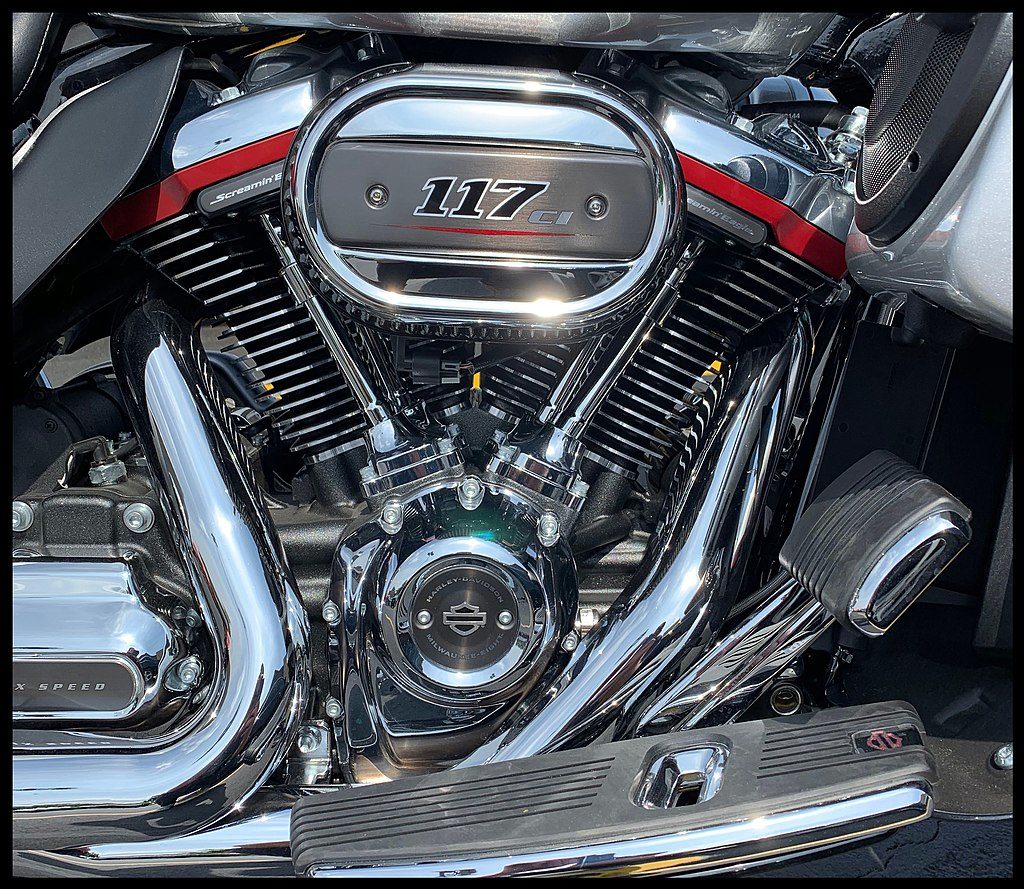
La Harley Davidson mitica casa motociclistica fondata il 28 Agosto del 1903 da William Silvester Harley e Arthur Davidson, che ha prodotto molti modelli che fanno battere il cuore a milioni di appassionati in tutto il mondo, deve gran parte del suo successo al bellissimo motore bicilindrico che spicca sempre come una prima donna in ogni modello prodotto.
Il motore classico della Harley-Davidson è il bicilindrico a V con i cilindri inclinati di 45 gradi, il cui progetto è ovviamente protetto da numerosi brevetti via via definiti nella storia; le bielle sono vincolate ad un’unica manovella dell’albero motore e questo fa sì che venga prodotto il caratteristico rumore di scarico che fa girare ogni passante per strada. La Harley-Davidson cercò anche di brevettare il suono del suo motore, rinunciandovi nel 2000 per vari motivi, in ogni caso le altre moto cutom giapponesi non producono un suono uguale.
I primi modelli Harley-Davidson utilizzavano motori fatti in casa o comunque prodotti in piccolo numero praticamente artigianali, poi nella storia seguirono numerosi altri modelli fino ad arrivare ai super evoluti motori odierni, alcuni dei quali prendono il nome dall’aspetto delle teste.
La gamma dei vari modelli V Twin sono:
- F-head, 1914–1929 1,000 cm³, e 1922–1929 (1,200 cm³)
- Flathead dal 1930–1949 1,210 cm³ (74 in³) e 1935–1941 1,300 cm³ (80 in³).
Questo motore di fatto a dato inizio alla produzione in più larga scala dei modelli Harley con una struttura più massiccia e affidabile, lo si riconosce per gli imbocchi dei collettori laterali e per la colorazione scura dei cilindri e color alluminio chiaro delle teste. Le valvole sono disposte lateralmente rispetto al cilindro con una minor complessità di progettazione e costruzione del motore, ed ecco perchè è stato in voga per così tanto tempo. I primi modelli di SV Flathead sono stati i modelli W da 340 e 500 cc e poi i DL e RL fino agli anni quaranata nche se il WL (successore del W) è stato montato in alcuni modelli fino ai primi anni settanta.
- Knucklehead dal 1936-1947, 1.000 cm³ (61in3) e 1.200 cm³ (74in 3)
Il Knuckle era un propulsore bicilindrico a V stretta di 45° raffreddato ad aria, con sistema di distribuzione ad aste e bilancieri, una cilindrata di 1.000 cm³ e due valvole in testa per cilindro: in pratica è il propulsore che inaugura la serie dei grandi bicilindrici HD (‘big twin’), i quali manterranno lo stesso schema e le stesse caratteristiche, poi sostituito dal mitico Panhead
- Panhead dal 1948-1965, 1.000 cm³ (61in3) e 1.200 cm³ (74 in3)
Inizialmente di 1.000 cc per i primi modelli, dotati di basamento di derivazione del precedente Knucklehead, fu portato poi a 1.200 cc, cilindrata che è stata mantenuta anche dal successivo modello Shovelhead fino al 78. L’alimentazione era fornita da un carburatore Linkert. Il Panhead era accoppiato ad un cambio a mano a 4 rapporti, con trasmissione finale a catena.
- Shovelhead dal 1966-1984, 1.200 cm³ (74 in3) e 1.340 cm³ (80 in3) dalla fine del 1978
Classico motore di 45°, con distribuzione ad aste e bilancieri, due valvole in testa a cilindro, un albero a camme nel basamento con trasmissione primaria e finale a catena, il raffreddamento ovviamente era ad aria non passava per la testa a nessuno a Milwaukee di adottare un radiatore. Alimentato da un carburatore. Prodotto fino all’84 è il motore che ha fatto viaggiare i chopper anni 70 in tutto il mondo spianando la strada ai figli dei fiori americani. Il nome deriva dalla forma dei coperchi delle valvole, che ricorda quella di un badile.
- Evolution (detto anche “Blockhead”), 1984-1999, il mitico 1.340 cm³ a carburatori (80 in3)
E’ il classico motore Harley 1340 a carburatore, con architettura del propulsore analoga a quella dei suoi predecessori cioè bicilindrico a V di 45° con aste e bilancieri e no radiatore, ma l’affidabilità è assolutamente superiore e ne fa quindi il primo motore moderno della Harley-Davidson, il motore che tutti gli appassionati Harley hanno apprezzato. Da notare che la capacità di 82 pollici cubi è la stessa degli ultimi Shovelhead con cui ha in comune la struttura del basamento, pur avendo una potenza superiore anche se non era la ricerca delle prestazioni il suo obiettivo.
- Twin-Cam (detto anche “Fathead”), 1999-2006, 1.442 cm³ (88 in3) portato dapprima a 95 in3, poi a 96 in3 dal 2007, ma disponibile anche con 98 in3, 103 in3 e 110 in3
E’ un bicilindrico a V di 45° raffreddato ad aria, con 2 valvole in testa per cilindro e due alberi di distribuzione alla base (da cui deriva il nome), inizialmente alimentato a carburatore singolo e successivamente ad iniezione elettronica. Proprio per questo motivo determina un po l’inizio di una svolta rispetto alla struttura classica fin qui adottata dai motori Harley.
- Milwaukee-Eight (da settembre 2016 solo su modelli Touring e da settembre 2017 anche su Softail). Milwaukee-Eight 107 (1745 cm³) con raffreddamento ad aria e olio (da sett. 2016); Milwaukee-Eight 114 (1870 cm³) con raffreddamento ad aria e olio (da sett. 2017 solo su alcuni Softail); Twin-Cooled Milwaukee-Eight 107 (1745 cm³) con testate raffreddate a liquido, (da sett. 2016); Twin-Cooled Milwaukee-Eight 114 (1870 cm³) con testate raffreddate a liquido (da sett. 2016 a sett. 2017 versioni CVO); Twin-Cooled Milwaukee-Eight 117 (1920 cm³) con testate raffreddate a liquido (da sett. 2017 versioni CVO). Quest’ultimo, con una cilindrata di 1920 cm³, è il motopropulsore più grosso costruito fino ad oggi dalla casa di Milwaukee. Diciamo che questo è il motore dell’era moderna che ha portato continue modifiche e innovazioni rispetto a quelli che erano stati fino a poco prima i motori Harley classici.
Ci sono poi una serie di motori di minor successo o minor impatto o riguardante modelli più piccoli e meno venduti:
Small V-twins:
- D Model, 1929–1931, 750 cm³
- R Model, 1932–1936, 750 cm³
- W Model, 1937–1952, 750 cm³
- G (Servi-Car) Model, 1932–1973, 750 cm³
- K Model, 1952–1953, 750 cm³
- KH Model, 1954–1956, 900 cm³
- Ironhead, 1967-1984, 883 poi portato a 1.000 cm³
- Evolution, dal 1986 ad oggi, 883 e 1.100 cm³ poi portato a 1.200 cm³ nel 1988.
Revolution:
- Revolution, dal 2002 al 2007, 1.130 cm³, dal 2008 al 2017 1.250 cm³.
Revolution X:
- Street da 500 cm³ o 750 cm³ dal 2014
ENGLISH VERSION: ——————————————————————-
The legendary motorcycle manufacturer Harley Davidson founded on August 28, 1903 by William Silvester Harley and Arthur Davidson, which has produced many models that make the hearts of millions of fans beat around the world, owes much of its success to the beautiful twin-cylinder engine that always stands out as a first woman in every product model.
The classic engine of the Harley-Davidson is the V-twin with cylinders inclined by 45 degrees, the design of which is obviously protected by numerous patents by means defined in history; the connecting rods are constrained and selected crank of the engine oil and this causes the characteristic exhaust noise that makes every passerby on the street turn. Harley-Davidson also tried to patent the sound of its engine, giving it up in 2000 for various reasons, however the other Japanese motorcycles do not use the same sound.
The first Harley-Davidson models used home-made engines or in any case practically handcrafted products in small numbers, then in history many other models followed up to today’s super-advanced engines, some of which are known by the name appearance of heads.
The range of the various V Twin models are:
- F-head , 1914–1929 1,000 cm³, and 1922–1929 (1,200 cm³)
- Flathead from 1930–1949 1,210 cm³ (74 in³) and 1935–1941 1,300 cm³ (80 in³).
This engine actually started the production on a larger scale of the Harley models with a more massive and reliable structure, it is certified for the ports of the side manifolds and for the dark coloring of the cylinders and the light aluminum color of the heads . The valves are arranged laterally than the cylinder with less engine design and construction complexity, which is why it has been in vogue for so long. The first models of SV Flathead were the W models from 340 and 500 cc and then the DL and RL until the past years after the WL (successor of the W) was integrated into some models until the early seventies.
- Knucklehead from 1936-1947, 1,000 cm³ (61in 3 ) and 1,200 cm³ (74in 3 )
- Panhead from 1948-1965, 1,000 cm³ (61in 3 ) and 1,200 cm³ (74 in 3 )
Initially 1,000 cc for the first models, supplied with a derivation base of the previous Knucklehead, it was then brought to 1,200 cc, the displacement which was also maintained by the subsequent Shovelhead model up to 78. Power was supplied by a carburettor Linkert. The Panhead was responsible for a 4-speed hand transmission with a final chain drive. - Shovelhead from 1966-1984, 1,200 cm³ (74 in 3 ) and 1,340 cm³ (80 in 3 ) since the end of 1978
Classic 45 ° engine, with rod and rocker distribution, two cylinder head valves, a camshaft in the crankcase with primary and final chain drive, the cooling obviously was an air that did not pass through the head to no one a Milwaukee of used a radiator. Powered by a carburetor. Produced until 1984, it is the engine that made 70’s helicopters travel all over the world, paving the way for the American flower children. The name derives from the shape of the valve covers, which resembles that of a shovel. - Evolution (also called “Blockhead”), 1984-1999, the legendary 1,340 cm³ carburettor (80 in 3 )
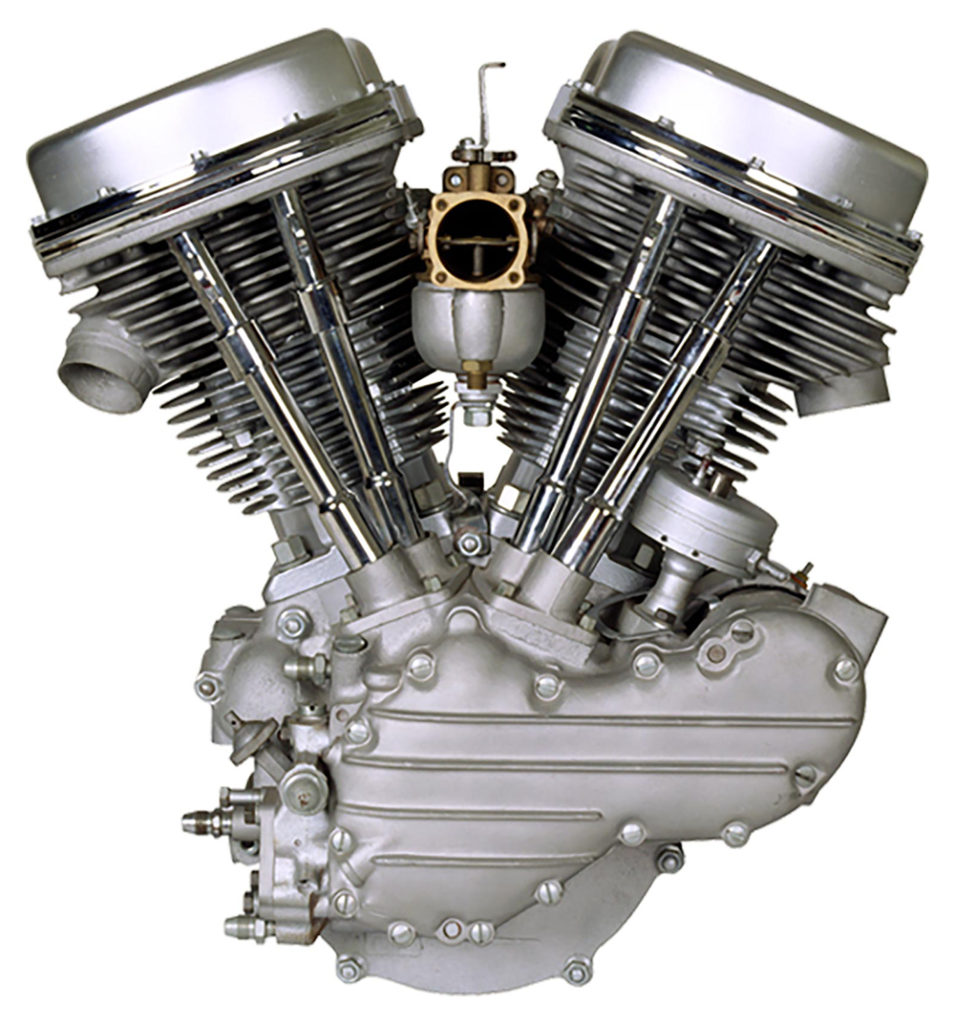
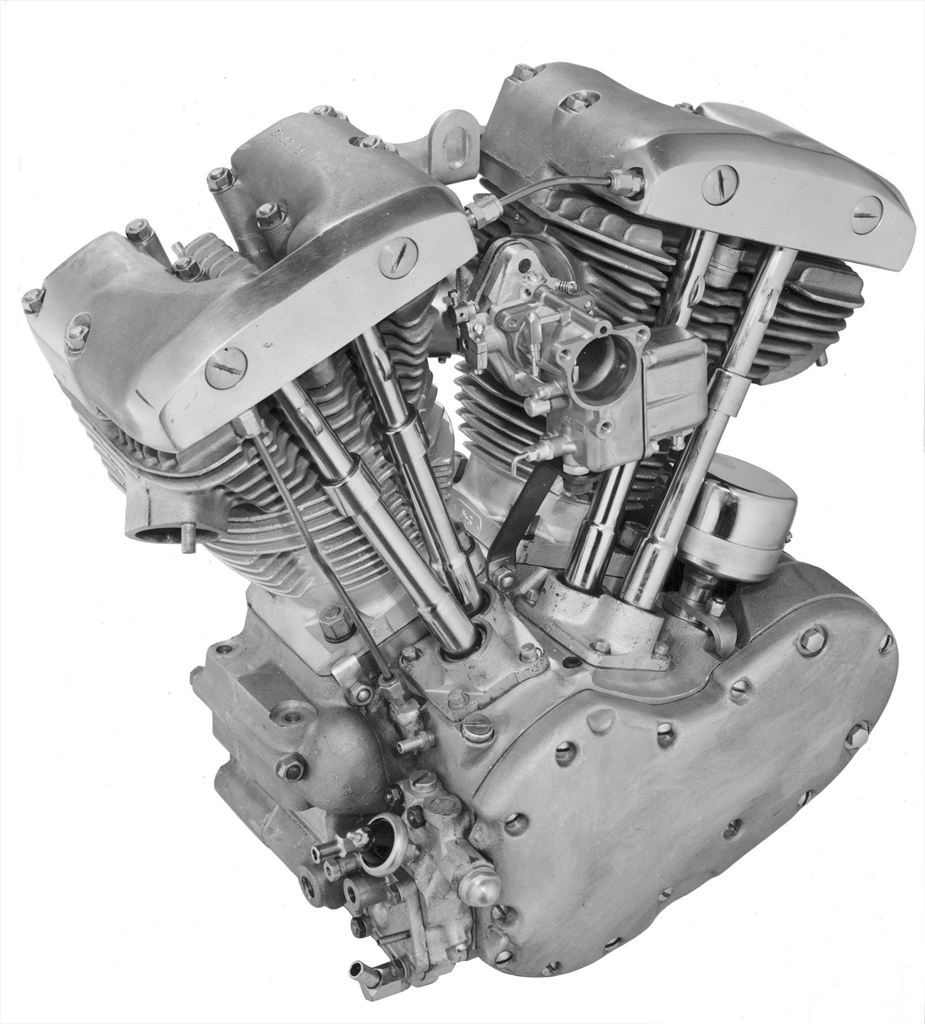
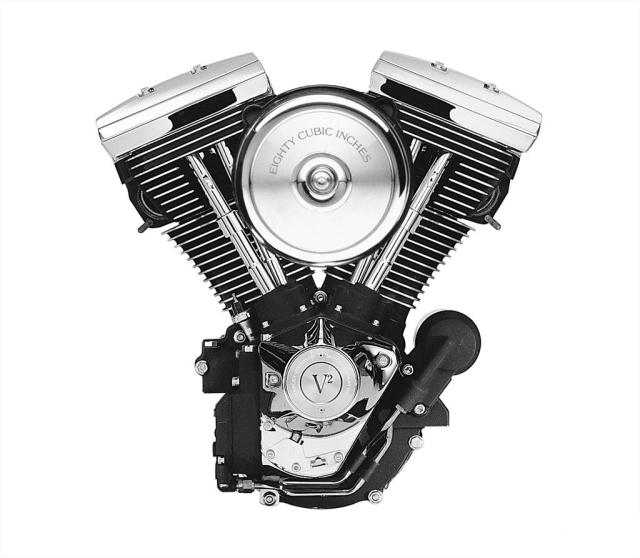
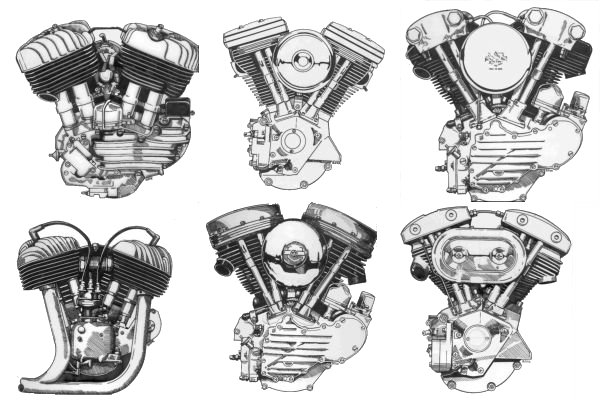
Blog Bobber Chopper Gruppo motociclistico Harley Davidson Kustom Kulture Mondo Kustom Moto Prima pagina


